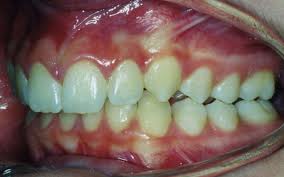 When a dentist talks about your “bite,” she’s referring to your occlusion, which means how your top and bottom teeth fit together. Optimal occlusion occurs when opposing teeth come together in their ideal arrangement. But when your teeth are misaligned, called malocclusion, a whole host of issues can result, including headaches, jaw pain, the wearing away of tooth enamel, and even cracked or loose teeth.
When a dentist talks about your “bite,” she’s referring to your occlusion, which means how your top and bottom teeth fit together. Optimal occlusion occurs when opposing teeth come together in their ideal arrangement. But when your teeth are misaligned, called malocclusion, a whole host of issues can result, including headaches, jaw pain, the wearing away of tooth enamel, and even cracked or loose teeth.
The Right Smile Center helps you achieve beautiful, healthy smiles – the right smile. And optimal teeth alignment is a crucial component to the right smile. I promise you, you can’t have a great smile if your teeth, gums, joints, and muscles don’t function in harmony with each other. And the prosthodontic training I received at Emory University School of Dentistry allows me to give patients smiles that look great, feel great and function properly.
During your exam, our team will look at how your top and bottom teeth come together when you bite down. We also assess the wear patterns on your teeth. And of course, we are going to make recommendations that help your smile be a proud part of your expression.
Another term for this, equilibration, means restoring optimal contact between upper and lower tooth surfaces to prevent the abnormal wear and tear on your teeth, joints, and muscles. Oftentimes, a slight adjustment made to the surface of a tooth makes a huge impact on occlusion.
Also, with the addition of Dr. Hanna Orland to our practice, we are now offering in-house orthodontic treatment to adjust your anterior (front) teeth with clear aligners. So, if we can be of service please feel free to contact us for a complimentary consultation.
Novy Scheinfeld, DDS, PC
ZoAnna Scheinfeld, MS, DMD
Hanna Orland, DMD
290 Carpenter Drive, 200A
Atlanta (Sandy Springs), GA 30328
404-256-3620
and
3781 Chamblee Dunwoody Road
Chamblee, GA 30341
770-455-6076
Related articles
- Dentist Sandy Springs: How Much Do Dentures Cost? (therightsmile.wordpress.com)
- Dentist Sandy Springs: How Much Do Dental Bridges Cost? (therightsmile.wordpress.com)
- Dentist Sandy Springs: How much does having a tooth pulled cost? (therightsmile.wordpress.com)
- Dentist Sandy Springs: How Much Do Dental X-rays Cost? (therightsmile.wordpress.com)








